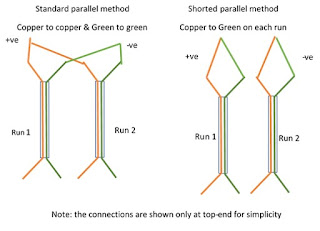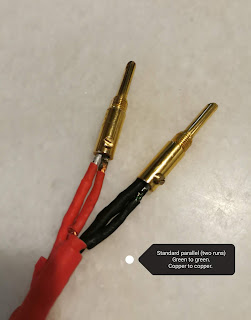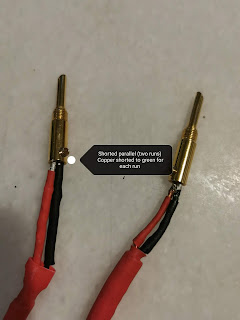Polk Cobra in parallel, why and how!
Polk Cobra:To single or parallel and how, that is the question!
When I first read about running Polk Cobra Cables in parallel, I thought it strange. After all nobody suggests to run six parallel lamp cord to make it same as a Monster Cable, at least in thickness! (Now that's an idea for you cable-nay-sayers out there :-)).
But as Arthur says, it works. It turns the Cobra cable from really good cable to a world-class cable. On why that is so, I refer you to the Polk Cobra Guru high-endaudio.com
Next important question? Why six? I have tried 2-parallel, 3-parallel and 6-parallel. There is gradual change as you increase the number of parallel, but it does not have the 'Wow' kind of change until you go from three to six. From single to 2 to 3, you have to go back and forth with bass heavy music to pin down the change. But once you reach six parallel the bass lines becomes really rich and melodic and underpins the music higher up the frequency. Its not just the bass that changes. Taking out the six parallel and replacing it with a single run in my tube system feels like some of the musicians went for break. But if you value clarity above all, you may prefer single run. My wife picked a single run as best sound when compared to a six paraallel. Clear, says she.
My own theory is that with six parallel the impedance (rather complicated function of resistance, inductance and capacitance because it depends upon frequency too) or some hitherto unmeasured property drops below a threshold value. Well, some-day I may do a twelve parallel and tell you how much better that is...
So whats the problem, other than cost? The problem with Polk Cobra design is the high capacitance. Hence the long standing joke: take lamp cord, solder a 1/5/10 nF capacitor in parallel and you have a Polk Cobra on the cheap. (Anyone tried that?). And capacitance in parallel adds up. So we reduce one problem (high DC resistance) by increasing another problem (high Capacitance).
After some experiments (due to too much lock-down time, too many Cobras in my DIY cabinet and my challenging best friend), I have found a way to parallel cobra cables while reducing capacitance significantly. Thirty year old problem of Cobra Capacitance is finally tamed.
Here is my report in detail. Arthur Salvatore was surprised enough by my results to publish my letter (unfortunately but not my report). Thank you Arthur. If fact, the main motivation for starting this blog is share this results with Polk Cobra fans.
This new method has two significant benefits:- Makes Cobra Cable suitable suitable for SS amplifiers.
- Solves the problem of accidental shortage due to cable damage.
Polk Cobra Alternative
Parallel Methods Study
Report date: 19 April 2020
Conducted by: timurmusicfan@gmail.com
Study purpose:
To find a method to parallel Polk Audio Cobra
cable without increasing capacitance.
Study method:
1. Prepare
cables.
a. Single
run, round version 2m pair
b. Standard
parallel method, round version, 2m (see Fig 1 & Fig 2)
c. Shorted
parallel method, round version, 2m (see Fig 1 & Fig 3)
d. 4.5m
pair of QED Silver Anniversary cable used as reference.
2. Measure
Capacitance and Inductance.
3. Tabulate
results. If results are OK, proceed to next step.
4. Compare
Cobra Standard 2-Parallel with Shorted Parallel by installing in test system
(Class D amplifier & bookshelf speakers) for functional test. If OK, go to
next step. (see Fig 5)
5. Install
in main system (SET amplifier & floor stander speakers) for audition (sound
comparison)
Table
1: Test results (Experimental data)
Design
|
Brand
|
Polk Cobra
|
Polk Cobra
|
Polk Cobra
|
Polk
Cobra
|
QED Silver
|
Comments
|
Cable type
|
Round
|
Round
|
Round
|
Round
|
Round
|
||
Length
|
2m
(run 1)
|
2m (run 2)
|
2m
|
2m
|
4.5m
|
||
Number of runs
|
Single
|
Single
|
2 parallel
|
2
Parallel
|
Single
|
||
Parallel
Configuration
|
None
|
None
|
Standard
|
Shorted
|
None
|
||
Parameter
|
Capacitance (nF)
|
3.04
|
3.06
|
6.18
|
0.11
|
0.19
|
Meter limit 0.001nF
|
Inductance(mH)
|
0
|
0
|
0
|
0
|
0.01
|
Below meter measurable range 1mH
|
|
0
|
0
|
0
|
0
|
0.01
|
Verification of results:
Due to the unexpected extreme drop in Capacitance
value with the shorted parallel method, an additional verification step was
conducted using the 6-standard parallel 2.5m cable.
·
Step 1: Measure Capacitance in
6-parallel configuration.
·
Step 2: Short the
Green-to-green terminal on both ends. Short Copper to copper terminals of the
two parallel runs (of six). This effectively makes it a 12-parallel cable using
standard parallel method. Measure capacitance.
·
Step 3: Short Green to Copper
terminals of the same run together. Do this for both runs but do not short
between the two runs. This makes it a 12
Shorted Parallel cable. Measure capacitance. (cable used shown in Fig 5, bottom
pair)
Table
3: Verification test results (experimental data)
Cable
type
|
6 Parallel, 2.5m,
|
12 parallel, 2.5m
|
12
parallel, 2.5m
|
Parallel
method
|
Standard
|
Standard
|
Shorted
|
Capacitance
nF
|
30.9
|
61
|
0.32
|
Functional test (test system):
No problems.
Sound review (main system):
Results of audition: Shorted parallel sounds
same as Standard parallel with a SET amplifier.
Test subject: Ex-professional Rock-Guitarist/Recording
artist
Test system: Mingda Piccolo KT90 SEP amplifier,
Spatial Hologram M4 speakers, Pioneer N70A streamer.
Next plan: Compare the two cables (two
parallel) in my second SS system (where I expect to hear a difference). If sounds
good, I will go ahead with making a Shorted 6-parallel to compare with my
Standard 6 parallel.
Due to current lockdown in Malaysia it is not
possible to complete a proper audition at the moment.
Conclusions:
1. The
new parallel method is effective in reducing capacitance significantly.
2. The
new method does not significantly affect Inductance (there is no measurable increase).
3. The
parameters make the shorted parallel Cobra closer to ‘the ideal speaker cable’ (near
zero capacitance & near zero inductance). Although DC resistance was not
measured, it can be safely assumed that DC resistance has also dropped with
parallel configuration.
4. The
shorted parallel method sounds as good as a standard parallel in a SET (Tube)
amplifier system.
5. An
interesting observation here is that a two shorted-parallel run of Polk Cobra
will be ideal for Solid State systems. An evaluation is planned after lock-down.
6. With
the shorted parallel method, the Polk Cobra becomes a safe cable, no more
amplifier killer. In the original design the positive and negative strands are
woven together and any damage to enamel will short the cable and damage the
amplifier. In the Shorted parallel configuration enamel damage (in case it
happens) will not short the positive and negative strands.
7.
Next
step (for me):
·
More auditions after Covid-19
lock-down (assuming, of course, that I survive).
·
Better measurements including
Inductance, DC resistance and ESR for two, four and six parallel runs. Again,
this will have to wait till end of Lock-down.
Invitation to fans of Polk Cobra:
If you happen to have two pairs (or more) of
Polk Cobra cables of equal length, you can try to do replicate this experiment
without having to solder or change anything permanently. Just connect in
Standard Parallel (see fig 1 & 2, left) and Shorted Parallel (see fig 1
& 2, right) configurations as shown in my photos and try it out. Please do
not try the Standard Parallel with your vintage Solid State amplifier
(Capacitance adds up in standard parallel) but you can safely try the Shorted
Parallel method with all amplifiers. If you have a tube or SET amplifier, you
can try both. I will be happy to read your reports/findings in the comments. I
do hope someone will be able do a comparison of sound quality between the two
parallel methods.
Weaknesses of this study:
1. Ideally,
all cables should have been of equal length.
2. Both
my meters bottoms out at 1 mH for inductance and 1 Ohm for resistance. A meter
with pico Henry range and milli Ohm range would have yielded more insight about
changes in Inductance and Resistance with new method.
3. The
meters are DIY grade and not calibrated. But accurate enough for this study. I
used a 150H inductor, a 2nF capacitor and a 5 Ohm resistor to confirm accuracy
of the multi meter.
Discussion of results:
Although a drop in Capacitance was expected,
the actual drop was many orders of magnitude higher than expected. This can
probably be explained as follows.
·
In the Polk Cobra design 72
Green strands and 72 Copper strands are woven in such a way that:
o Individual
strands act like a coil (inductor).
o But
groups of six strands constantly cross each other in opposite directions at
right angles to cancel out inductance.
o But
half the green and copper strands are parallel to each other in close
proximity, increasing Capacitance.
o See
Figure 5.
·
With standard method of
parallel runs, the Copper strands are joined together and the Green strands are
joined. Technically all the capacitors (cables) are connected in parallel. See Figure
6.
·
With the new method, the Green
strands are shorted with the Copper strands (all 144 strands) shorting out the
capacitance within the same run of cable. Now the capacitance is between the
two separate runs of the cable. See Figure 6.
·
As expected, resistance will
drop with parallel runs.
·
It is not easy to figure out
what happens to the inductance because inductance in parallel may add up
(aiding) or reduce (opposing) depending upon configuration. Well, that’s the
next step in the study with higher resolution Inductance meter (any volunteers
out there?)
 |
| Fig 1: On the left is standard parallel, on the right shorted parallel |
 |
| Fig 2: Standard parallel. Copper strands from two runs are connected together. Same with green. |
 | |||
| Fig 3: Shorted parallel. Copper and green strands from same run are shorted together. So one run becomes the +ve and the other -ve. |
 |
| Fig 4: Capacitance of Standard 2-parallel ( Double that of single run capacitance is about 3nF) |
 | |
| Fig 5: Capacitance of Shorted 2-parallel (Lower than single run!) |
 |
| Fig 6: Simplified illustration of capacitance in a single run |
 |
| Fig 7: Simplified illustration of capacitance is single, standard parallel and shorted parallel configuration |
Comments
Post a Comment
Thank you for taking time to share your experience and comments. Appreciate it.